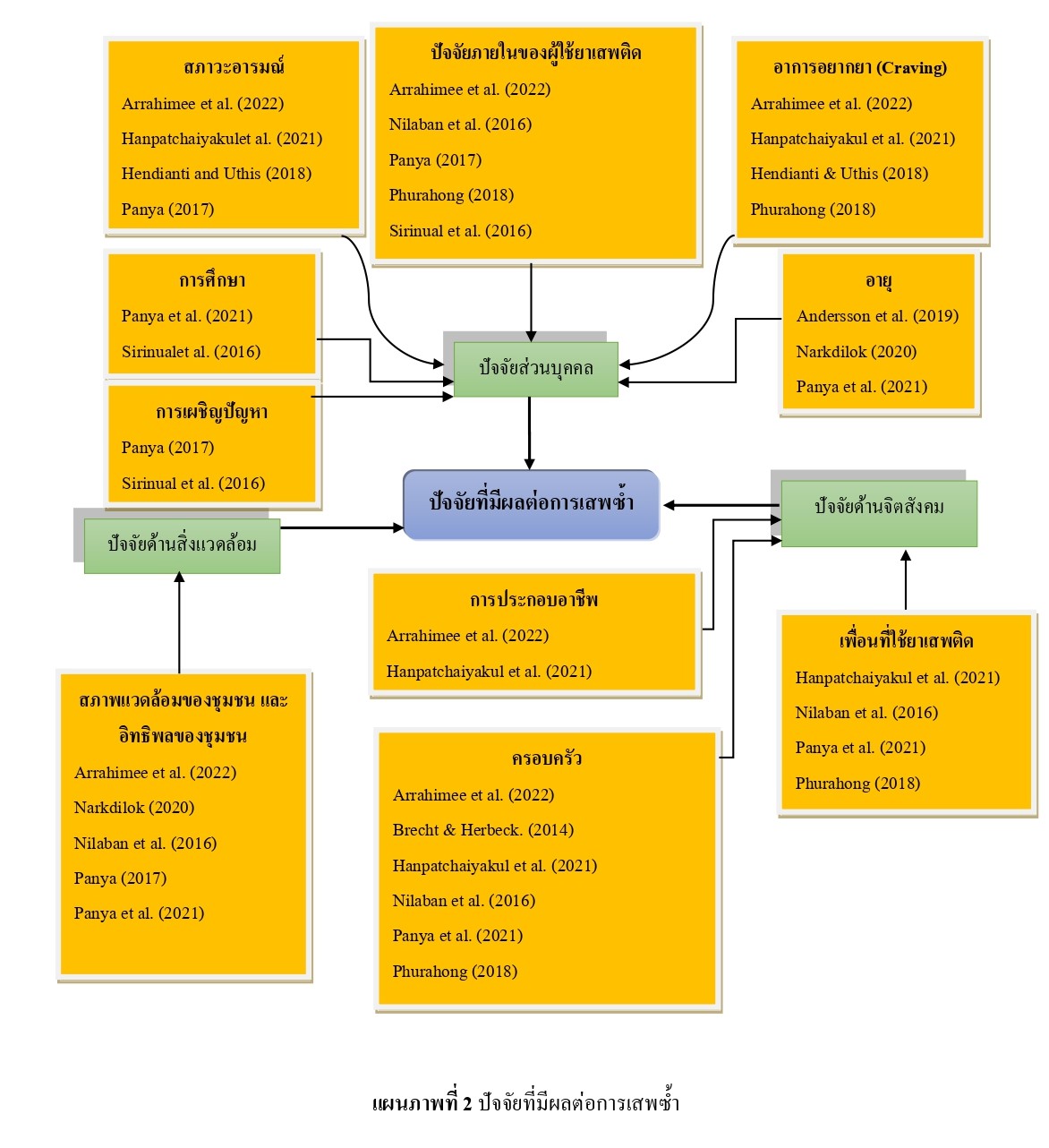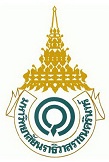ปัจจัยที่ส่งผลต่อการกลับไปเสพซ้ำในผู้ติดยาเสพติดชนิดผสมผสาน: การทบทวนวรรณกรรมอย่างเป็นระบบ
คำสำคัญ:
การกลับไปเสพซ้ำ, ผู้ติดยาเสพติด, ยาเสพติดชนิดผสมผสาน, การทบทวนวรรณกรรมอย่างเป็นระบบบทคัดย่อ
การทบทวนวรรณกรรมอย่างเป็นระบบนี้มีวัตถุประสงค์เพื่อศึกษา วิเคราะห์ และสังเคราะห์ปัจจัยที่ส่งผลต่อการกลับไปเสพซ้ำในผู้ติดยาเสพติดชนิดผสมผสานระหว่างเมทแอมเฟตามีนร่วมกับยาเสพติดชนิดอื่น โดยสืบค้นข้อมูลงานวิจัยทุกรูปแบบตั้งแต่ปี พ.ศ. 2557 ถึง พ.ศ. 2566 ประเมินค่างานวิจัยและสกัดข้อมูลโดยใช้แบบสกัดข้อมูลที่พัฒนาโดยสถาบันโจแอนนาบริกส์ ผลการสืบค้นพบงานวิจัยที่ศึกษาปัจจัยที่ส่งผลต่อการเสพยาเสพติดซ้ำในผู้ป่วยที่ใช้ยาเสพติดชนิดผสมผสานทั้งหมด 256 เรื่อง จาก 8 ฐานข้อมูล งานวิจัย 245 เรื่อง ถูกคัดออกเนื่องจากไม่ตรงตามเกณฑ์การคัดเข้า มีเพียง 11 งานวิจัยที่เป็นไปตามเกณฑ์การคัดเลือกทั้งหมด แบ่งเป็นงานวิจัยภายในประเทศ จำนวน 8 เรื่อง และงานวิจัยต่างประเทศ จำนวน 3 เรื่อง เป็นงานวิจัยหาความสัมพันธ์ จำนวน 5 เรื่อง งานวิจัยเชิงสำรวจ จำนวน 2 เรื่อง งานวิจัยแบบผสม จำนวน 1 เรื่อง งานวิจัยแบบศึกษาไปข้างหน้า จำนวน 1 เรื่อง และงานวิจัยเชิงคุณภาพ จำนวน 2 เรื่อง สังเคราะห์องค์ความรู้เกี่ยวกับปัจจัยที่ส่งผลต่อการกลับไปเสพซ้ำในผู้ติดยาเสพติดชนิดผสมผสานและผลการวิเคราะห์สรุปบรรยายเชิงเนื้อหา เพื่ออธิบายลักษณะของปัจจัยและความสัมพันธ์ระหว่างปัจจัยกับการเสพซ้ำ ผลการศึกษาพบว่า ปัจจัยที่ส่งผลต่อการเสพยาเสพติดซ้ำในผู้ติดยาเสพติดชนิดผสมผสาน คือ ปัจจัยส่วนบุคคล ได้แก่ อายุ การศึกษา อาการอยากยา ปัจจัยด้านจิตสังคม ได้แก่ เพื่อนที่ใช้ยาเสพติด ครอบครัว และการประกอบอาชีพ และปัจจัยด้านสิ่งแวดล้อม ได้แก่ สภาพแวดล้อมของชุมชนและอิทธิพลของชุมชน ผลจากการศึกษาสามารถนำไปพัฒนาต่อยอดในงานวิจัยและพัฒนาแนวทางในการป้องกันการเสพยาเสพติดซ้ำโดยการทำงานประสานกันระหว่าง สหวิชาชีพ ครอบครัว และชุมชนต่อไป
References
Andersson, H.W., Wenaas, M., & Nordfjærn, T. (2019). Relapse after inpatient substance use treatment: A prospective cohort study among users of illicit substances. Addictive Behaviors, 90, 222 – 228. https://doi.org/10.1016/j.addbeh.2018.11.008
Arrahimee, A., Saengthong, T., Jeawkok, J., & Laipaporne, S. (2022). Self-prevention against drug abise relapse: A case study of people undergoing drug addiction treatment in Pattani province. Journal of community development and life quality, 10(1), 345 - 357. http://he02.tci-thaijo.org/index.php/JCDLP/article/view/254736
Brecht, M.L., & Herbeck, D. (2014). Time to relapse following treatment for methamphetamine use: A long-term perspective on patterns and predictors. Drug and Alcohol Dependence, 139, 18 – 25. https://doi.org/10.1016/j.drugalcdep.2014.02.702
Hanpatchaiyakul, K., Kasemporn, N., Thoin, P., & Thongkote, N. (2021). Factors affecting the readmission of patients recovering from drug addiction. Journal of health science research, 15(2), 1 – 12. http://he02.tci-thaijo.org/index.php/JHR/article/view/247142
Hendianti, G.N., & Uthis, P. (2018). Factors related to methamphetamine relapse risk among clients in the substance rehabilitation center of National Narcotics Board in West Java, Indonesia. Journal of Health Research, 32(4), 279 – 287. https://doi.org/10.1108/JHR-05-2018-035
Kakko, J., Alho, H., Baldacchino, A., Molina, R., Nava, F.A., & Shaya, G. (2019). Craving in Opioid Use Disorder: From Neurobiology to Clinical Practice. Frontiers in Psychiatry, 10, 592. https://doi.org/10.3389/fpsyt.2019.00592
Kuypers, K., Verkes, R., van den Brink, W., van Amsterdam, J., & Ramaekers, J. (2020). Intoxicated aggression: Do alcohol and stimulants cause dose-related aggression? A review. European Neuropsychopharmacology, 30, 114 – 147. https://doi.org/10.1016/j.euroneuro.2018.06.001
Marlatt, G. A., & Donovan, D. M. (2005). Relapse prevention: Maintenance strategies in the treatment of addictive behaviors (2nd ed.). The Guilford Press. https://psycnet.apa.org/record/ 2005-08721-000
Ministry of Public Health. (2023, December 1). National drug addiction treatment and rehabilitation information system. Office of the Secretary of the Drug Addiction Treatment and Rehabilitation Committee. https://antidrugnew.moph.go.th.
Narkdilok, S. (2020). The study of incident rate with relapse use of methamphetamine at Princess Mother National Institute on Drug Abuse Treatment (PMNIDAT). Thai Journal of Addiction, 6(1), 47-58. http://he02.tci-thaijo.org/index.php/pmnidat/article/view/248483
Nilaban, S., Sriherun, B., & Kongthong, U. (2016). Causal relationship of factors affect relapsing behavior of methamphetamine users. Journal of Graduate Studies Valaya Alongkron Rajabhat University, 10(1), 193 - 207. http://So02.tci-thaijo.org/index.php/JournalGradVRU /article/view/55960
Panya, S. (2017). Study on the risk factors for repeated drug addiction among drug addiction patient at a drug addiction rehabilitation center in the northeast. In Ubonratchatani university. The 2st National Conference Ubon Ratchathani: 4.0 Research for the development of the country towards stability, prosperity and sustainability. (pp. 161-169). Ubonratchatani university.
Panya, S., Thajang, S., Chapik, N., Kanchanabut, S., & Mongkolsawad, J. (2021). The relationship between personal factors, psychosocial factors, and environmental factors among repeated methamphetamine recurrence in Thanyarak hospital. Nursing Journal, 48(2), 273 - 282. http://he02.tci-thaijo.org/index.php/cmunursing/article/view/247286
Phurahong, G. (2018). Factors affecting the relapsing of drug addicted patients in Pathumthani province. Journal of Public health nursing, 32(2), 23 - 40. http://So01.tci-thaijo.org/index. php/phn/article/view/245417
Princess Mother National Institute on Drug Abuse Treatment. (2023). Statistics on patients receiving treatment. Author.
Sirinual, S., Suphunnakul, P., Noosorn, N., & Wongsawad, P. (2016). Factors affecting amphetamine relapse among drug addicts after treatment. Journal of health science research, 10(1), 39 - 45. http://So02.tci-thaijo.org/index.php/JHR/article/view/68832
Siriwannabut, S. (2020). developmental psychology theory (3rd ed.). CUprint.
The Joanna Briggs Institude. (2014, May 16). Critical appraisal tools. http://joannabriggs.org/ research/ critical-appraisal-tools.htm
United Nations Office on Drugs and Crime. (2023). Global Overview: Drug Demand Drug Supply. Author.
Valentino, R.J., & Volkow, N.D. (2020). Drugs, sleep, and the addicted brain. Neuropsychophar macology, 45(1), 3 – 5 https://doi.org/10.1038/s41386-019-0465-x
Zeng, X., Lu, M., & Chen, M. (2021). The relationship between family intimacy and relapse tendency among people who use drugs: A moderated mediation model. Substance Abuse Treatment, Prevention, and Policy, 16(1), 48. https://doi.org/10.1186/s13011-021-00386-7

Downloads
เผยแพร่แล้ว
How to Cite
ฉบับ
บท
License
Copyright (c) 2024 วารสารมหาวิทยาลัยนราธิวาสราชนครินทร์

This work is licensed under a Creative Commons Attribution-NonCommercial-NoDerivatives 4.0 International License.


